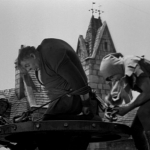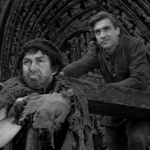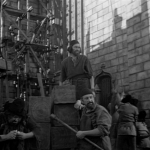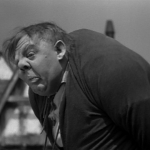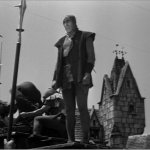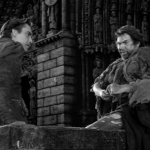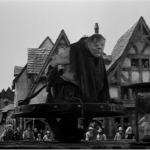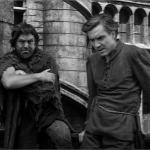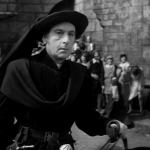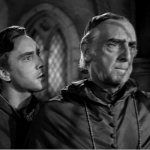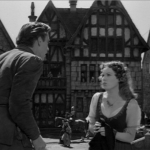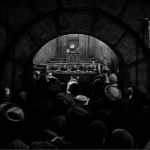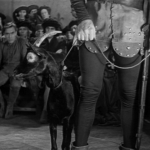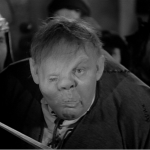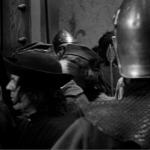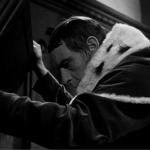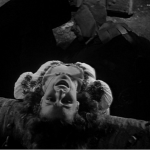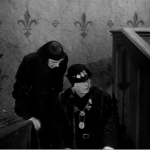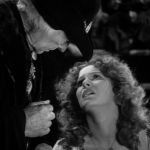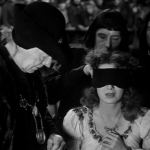So after looking at the plot overview let’s review it. The first thing to look at is the script. The script of 1939 version of the Hunchback of Notre Dame was written by Bruno Frank and Sonya Levien. Frank wrote an adaptation and Levien wrote a screenplay based off that adaptation. The thing to keep in mind about Frank’s adaptation is that he was a German author, poet, dramatist and humanist of Jewish descent. He fled Germany because he feared the Government and lived in Austria and England before going to America in 1937. He then starting working in Hollywood as a writer. So given the political environment of the late 30’s along with Frank’s experience it’s no wonder that the Hunchback of Notre Dame parallels Europe of the late 30s. Considering Frank’s background as an author/poet/humanist it’s understandable why Gringoire is co-hero with Quasimodo.
Speaking of Quasimodo and scenes that feature him, most of his lines are pretty much verbatim to what Victor Hugo wrote. The film also likes to insert him wherever it can: Louis commenting on the Bells and asking about the Bell ringer, the girl crying to grandmother about seeing him, scaring Esmeralda away from Notre Dame, confessing to Phoebus‘ murder, and him alone at the end. Clearly the film compensates for Quasimodo isn’t the main character in the book.
One of the major problems with the plot is that because there is this push towards modernity, which Louis and Gringoire represent, there are lot of scenes that are either completely added, like opening scene or added to much larger parts of the film so that Louis and Gringoire can be featured more. Quasimodo’s flogging and Esmeralda’s trial are good examples. The pillory scene cuts away to other characters and sometimes just random extras, but it mainly cuts to Gringoire and Clopin, who are talking about the truth about beggary and Gringoire wanting to help Quasimodo, so he prolonged in the scene further by seeing Claude. Esmeralda’s trial has interjects made by Gringoire pleading for common sense, Quasimodo confessing to the murder, and Louis giving Esmeralda a “Trial by Ordeal” the “ordeal” is more chance, basically she just has to touch the right dagger (Louis) to be freed but she fails. These add on don’t add much and if they accomplish anyway it weak character develop at best.
all these pictures are all from the “pillory scene” and now for the trial
this scene does not have as many ADD-ons as the pillory scene but when Quasimodo comes in it just falls apart and having Louis there makes it worst.
Another big problem is Frollo’s obsession/lust for Esmeralda comes off very contrived. He sees her dance, he stares but I don’t think he is enchanted by her at that moment. Their discussion in Notre Dame is just there so he can talk to her. He starts by letting his prejudices and superstition about her and her people be known and thne he stares at her breasts for more than a few seconds. And while that part is quite amusing, it seems so forced, it almost like he bored of talking to her. After that the talk takes a dive because they strike an accord over a mutual love of animals, for no explain reason Frollo keeps a dozen cats in his office, I guess this would explain why he took in Quasimodo in the first place. Anyway it seemed that Frollo and Esmeralda could be have friends if Quasimodo haven’t scared her and he tried to kidnap her. A side point about the kidnapping, at the point where Esmeralda fled from Notre Dame she apparently lived in sanctuary because she didn’t have a city permit and would be arrested for not having one, so seemed like the “kidnapping” was only to take her back to safety. It’s good thing the guard who recused her didn’t ask for her permit, actually the permit thing is never mention again, it completed its’ mission for the plot. Anyway back to the Frollo/Esmeralda dynamic, given his tepid feeling and her lacking of feeling anything towards him, this makes the confession scene odd. Esmeralda and Gringoire are performing and for some weird reason Frollo is hosting. He asks Gringoire if he is ready to perform. When Gringoire is out the way , Frollo makes his move and confesses his confused little feelings. Now prior to this scene Frollo tried exactly once to find Esmeralda, he had all the Gypsy girls in the Court of Miracle arrested and then released because Esmeralda wasn’t there. So he didn’t shown his powerful obsession/lust, so it hard to buy his torment. Prior to this we know that Esmeralda doesn’t have any strong dislike of Frollo, so I don’t buy her fear in this scene either. Then she goes off with Phoebus and Frollo kills him again I don’t believe he was pushed to murder. Since Frollo is the catalyst that causes the story to take motion, the Frollo/Esmeralda dynamic needs to strong, not there because the it was in the original.
I do like that the theme is old vs new and embraces the sprit of progress, it’s a nice change of pace for a Hunchback movie. The cliche theme for Hunchback films is “beauty is on the inside”. But the theme does tries to hard it assert itself and competes with original too much. I think the plot suffers because of this and ultimately the the plot and the screenplay are the weakest element of the film.
Next time we’ll look at the Mise-en-scene for the movie. see ya then!

